
The anti-drone market is estimated to be valued at US$ 2.17 billion in 2025 and is expected to reach US$ 10.86 billion by 2032, growing at a compound annual growth rate (CAGR) of 25.9% from 2025 to 2032.
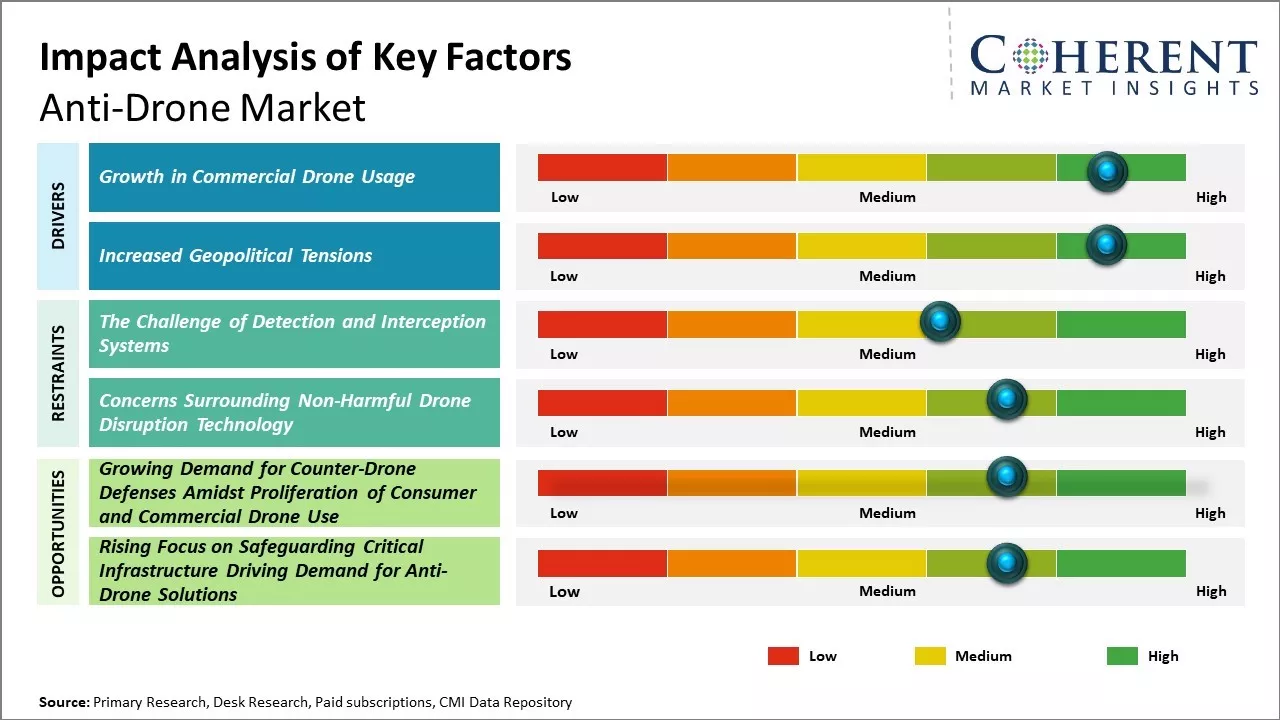
Discover market dynamics shaping the industry: Download Free Sample
The anti-drone market is expected to experience positive growth over the next few years. With the rising security threats from unidentified drones and increasing incidences of drone trespassing, the demand for anti-drone system is expected to rise significantly. Many government agencies and private end-users are planning to adopt counter drone technology to safeguard sensitive locations. Furthermore, advancement in AI and jamming technology will also support the market growth during the forecast period. However, spectrum interference issues and lack of coordinated counter-drone standards may impede the growth of the anti-drone market to some extent.
Growth in Commercial Drone Usage
As drones are being used increasingly for commercial purposes like package deliveries, infrastructure inspections, agricultural monitoring, and film making, the need for reliable anti-drone systems is rising. E-commerce giants are actively working towards building drone fleets to deliver packages within cities in under 30 minutes. This could revolutionize last-mile delivery operations and make online shopping even more convenient. However, with increased commercial drone traffic in low-altitude airspace, the risk of possible misuse of these drones for sabotage or surveillance also rises. Key companies need assurances that unauthorized drones cannot interfere with their operations or steal sensitive data. While commercial drones offer a lot of benefits, ensuring safety at large public events, important installations and restricted areas will require monitoring airspace and mitigating threats. As commercial drone delivery takes off in the next few years, the demand for anti-drone defense from large corporations, event organizers and government agencies is likely to grow substantially.
For instance, during the Texas Department of Public Safety Drone eXpo in December 2022, DeTect showcased its DroneWatcher system, capable of wide-area drone surveillance and detection, identifying over 95% of commercially available drones.
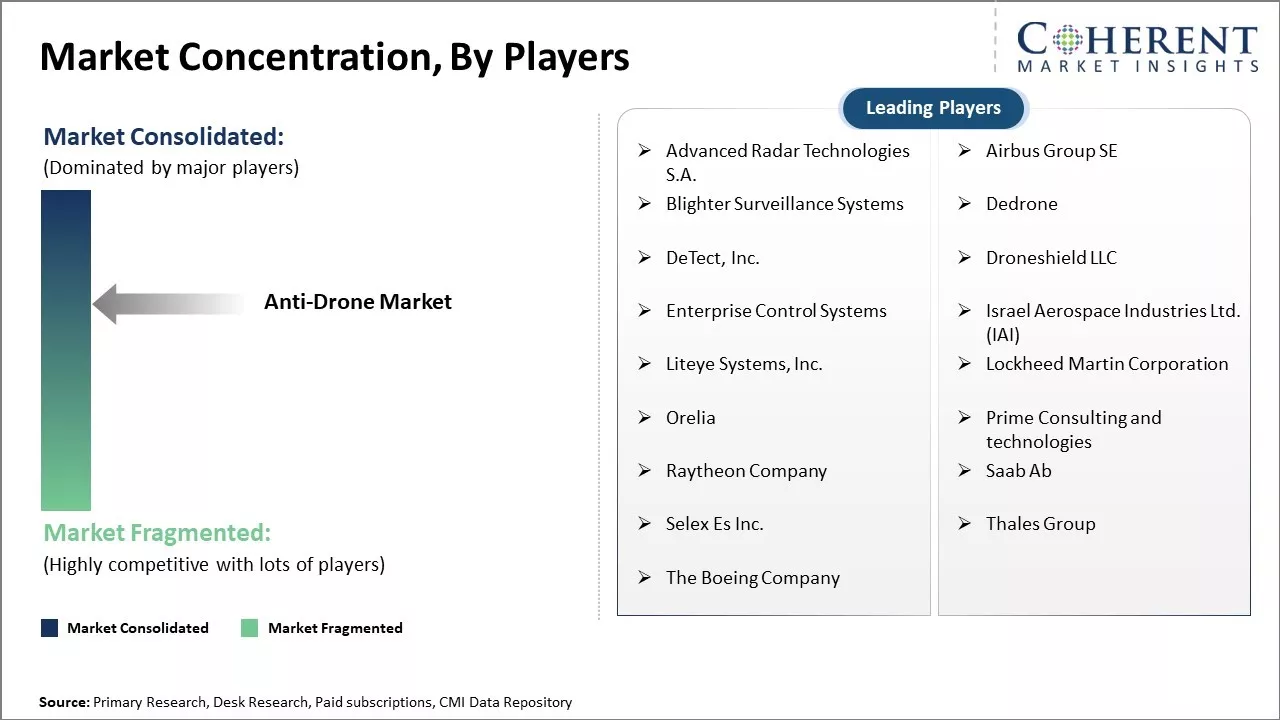
Get actionable strategies to beat competition: Download Free Sample
Increased Geopolitical TensionsIn the current world order marked by geopolitical conflicts and tensions between nations, proliferation of small drones poses serious challenges for national security. While drone technology progress has been rapid, mitigating rogue drone threats still remains a work in progress for militaries and law enforcement. There have been reported incidents of enemy drones striking nearby bases in ongoing border conflicts. At the same time, terrorist groups are also known to use off-the-shelf drones for surveillance and attacks. The threat landscape is continuously evolving as drone payloads expand to include explosives, chemical, and biological weapons. Furthermore, adversarial nations like North Korea and Iran have boosted their drone arsenal significantly. This has many countries significantly ramping up counter-drone defenses around sensitive military installations, energy infrastructure, borders, and urban centers. Rising geo-political tensions are a major driver as governments spend more on airspace security and related anti-drone technologies like radio-frequency jammers, detector sensors, and interception systems.
For instance, in August 2021, Meteksan Defense introduced an upgraded version of its Kapan counter-drone system at IDEF 2021. This system features the latest Retinar FAR-AD radar for drone detection, along with enhancements to detect vehicles, supported by advanced computer systems and AI algorithms.
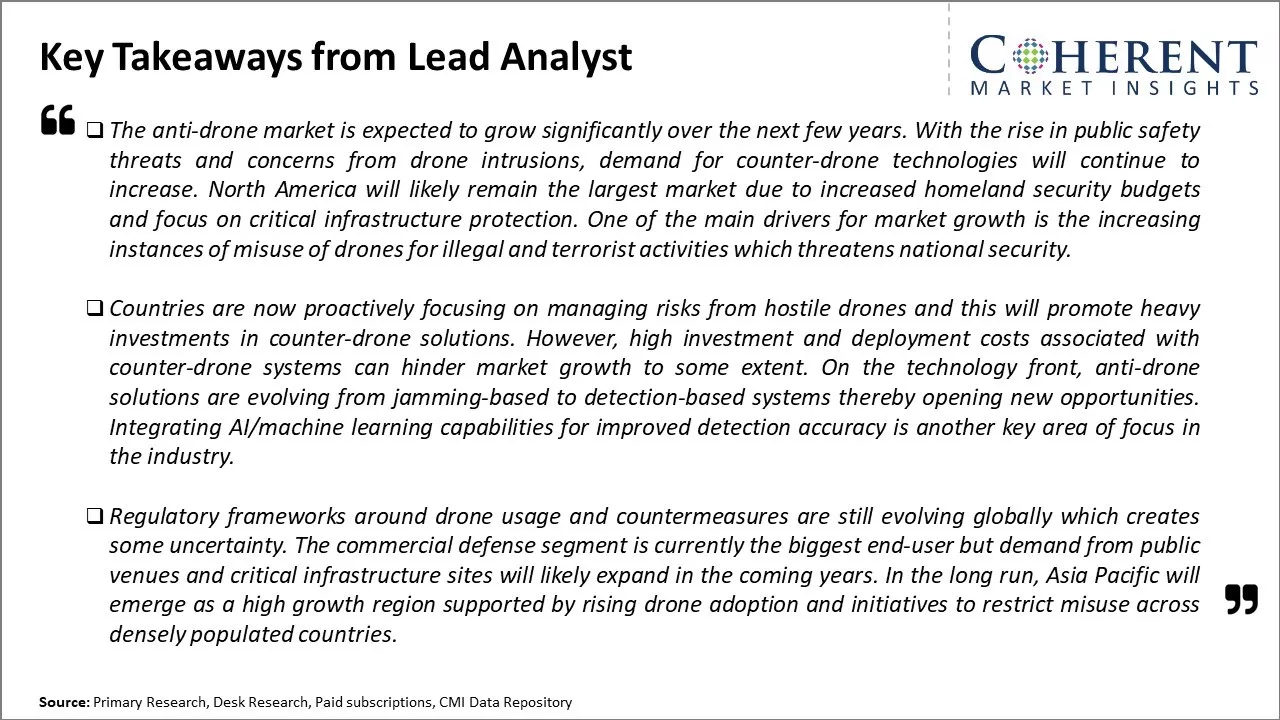
To learn more about this report, Download Free Sample
Market Challenges: The Challenge of Detection and Interception SystemsAs drone technology rapidly progresses, it becomes more difficult for detection and interception systems to keep pace in identifying and neutralizing new and unknown drones. Additionally, developing technology that can disrupt drones without causing harm raises safety and liability concerns. The lack of internationally recognized standards for the testing and evaluation of counter-drone systems also impacts the trust and adoption of anti-drone solutions.
Market Opportunities: Growing Demand for Counter-Drone Defenses amidst Proliferation of Consumer and Commercial Drone Use
The widespread consumer and commercial use of drones has highlighted the need for counter-drone defenses, especially around critical infrastructure. Governments and organizations are increasingly seeking solutions to monitor airspace and respond to potential drone threats. If international standards and guidelines can be established, it could help accelerate market acceptance and validation of anti-drone systems.
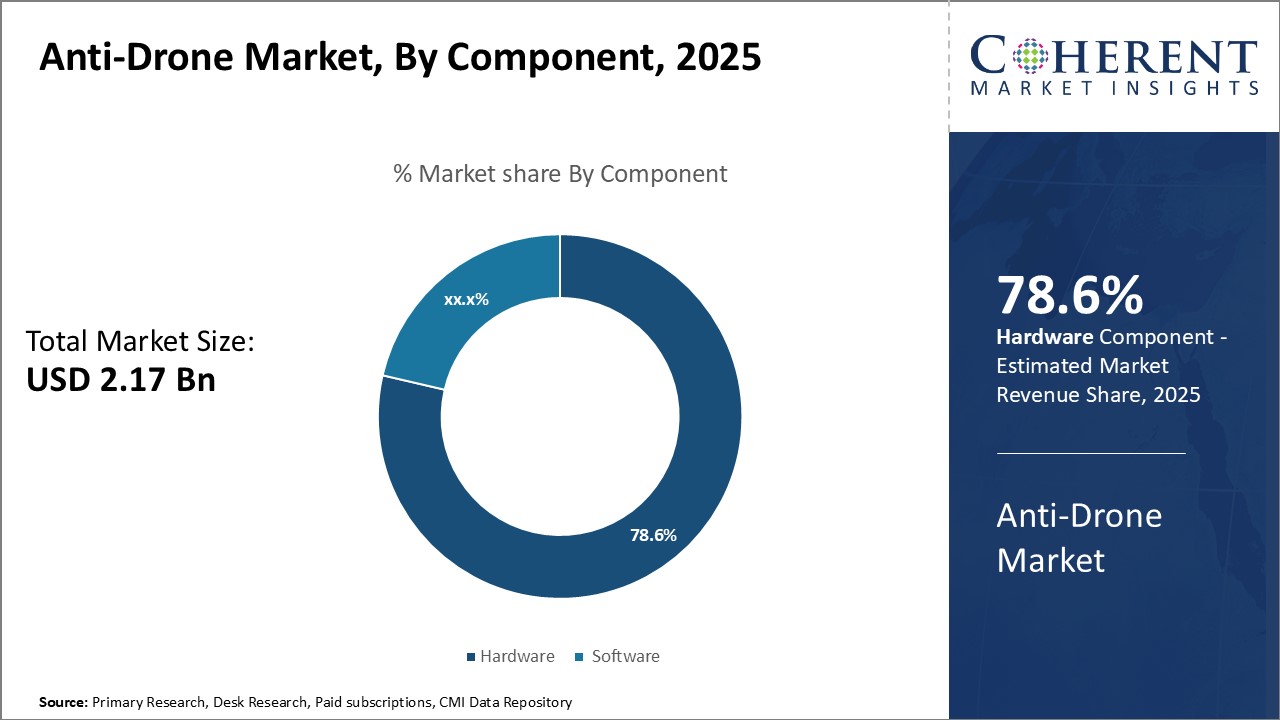
Discover high revenue pocket segments and roadmap to it: Download Free Sample
Insights, By Component, Hardware: Driving force behind anti-drone market growthIn terms of components, hardware contributes the largest share of 78.6% in 2025, to the anti-drone market due to advancements in technologies. Hardware components play a vital role in detecting, identifying, and neutralizing rogue drones. They utilize technologies such as radar, electro-optical/infrared systems and radio frequency systems to perform critical functions.
Radar systems effectively detect and track drones within a certain range depending on the wattage of the transmitted signal. Developments in phased array radar and software-defined radar have enabled high resolution detection of even miniscule drones. This has significantly boosted their adoption among defense agencies.
Electro-optical and infrared sensors provide visual confirmation of drones. Thermal cameras equipped with these sensors can identify drones day and night based on heat signature. Combined electro-optical/infrared and radar systems offer redundant detection for higher assurance. Advances in sensor fusion algorithms have made these dual-mode systems more reliable.
Radio frequency detection systems have undergone rapid evolution. By capturing signals between the drone and controller, they can identify the location of the pilot. Designs incorporate wideband receivers, signal processors and direction-finding capabilities. Upgrades in antennae and frequency agility allow capturing communications across different bands.
Hardware neutralization tools include jammers, interceptors, high-powered lasers, and projectile/kinetic interceptors. Developing more compact and portable versions of these effectors without compromising on capability is driving continuous hardware innovation. Governments are also investing in deploying hardware solutions to secure borders, gather intelligence, and conduct search & rescue operations.
Insights, By Platform - Ground-based: Mainstay of critical anti-drone infrastructure
Among platforms, ground-based systems are expected to account for the largest share of 48.21% in 2025 in the anti-drone market. They form the backbone of security for vital assets and public events due to their stability and coverage area. Fixed ground stations can detect drones within distances of 10-15 km depending on the radar type and environment. Mobile ground vehicles extend the perimeter when deployed strategically.
Ground-based detection systems offer seamless surveillance without gaps compared to other modes. Their transmission power is not constrained like handheld or UAV-mounted radars. Integration of multilayered sensors on ground towers ensures comprehensive aerial monitoring without blind spots. Additionally, ground infrastructure can be hardwired with stable power supply and high-speed networking for centralized command and control.
Effector payloads on ground platforms also allow for countermeasures from safe stand-off distances. Long-range hailing, tracking and jamming capabilities are crucial for securing airspace over sensitive facilities. Equipping mobile interception vehicles expands the response area. Kinetic weapons deployed on the ground provide assured neutralization of hostiles when other options fail.
Ruggedization and compatibility with diverse terrains make ground systems a universal solution. Their endurance surpasses temporary handheld and UAV options. Governments thus rely on permanent ground-based networks as the primary protective layer backed by mobile assets. This cements ground systems' leading position among anti-drone platforms.
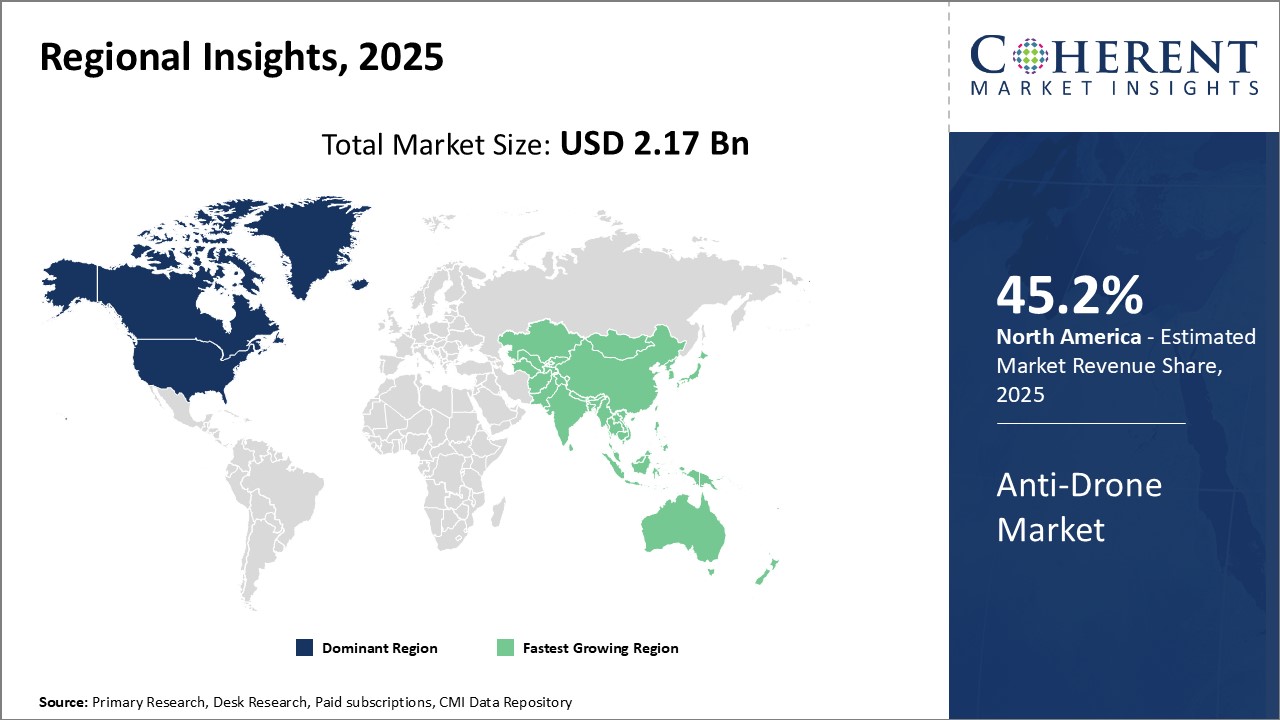
Need a Different Region or Segment? Download Free Sample
North America has established itself as the dominant region in the global anti-drone market and is expected to account for a market share of 45.2% in 2025. The U.S. accounts for the largest share owing to heavy defense spending and stringent regulations regarding drone security across critical infrastructure and national assets. Several U.S. government agencies such as Department of Homeland Security (DHS), Department of Defense (DOD), and Federal Aviation Administration (FAA) have implemented policies and issued guidelines necessitating the deployment of counter-drone technologies at airports, military bases, and other vital facilities. Moreover, the presence of key anti-drone system manufacturers such as Lockheed Martin, Northrop Grumman, Raytheon, and Leonardo make the regional market highly organized with varied product offerings. The suppliers also regularly upgrade their solutions based on the evolving drone threats, thereby maintaining North America's edge.
The Asia Pacific region is emerging as the fastest growing market for anti-drone systems globally with a CAGR of 29.09% in 2025. Countries like China, India, and Japan are aggressively focusing on countering the menace of unidentified or rogue drones around important locations. Rapid economic expansion and development of smart cities in these nations have stimulated the requirement for reliable drone detection and security solutions. Additionally, increasing drone imports and indigenous drone manufacturing in the region have also raised concerns about airspace security. Local governments are proactively engaging with international anti-drone suppliers and encouraging joint ventures with domestic technology firms to address this challenge. The competitive business environment and large defense budgets provide fertile ground for anti-drone adoption across Asia Pacific. The region presents lucrative opportunities for market players to establish local production centers and supply chain networks to effectively gain ground in this fast-developing landscape.
Anti-Drone Market Report Coverage
| Report Coverage | Details | ||
|---|---|---|---|
| Base Year: | 2024 | Market Size in 2025: | USD 2.17 Bn |
| Historical Data for: | 2020 To 2024 | Forecast Period: | 2025 To 2032 |
| Forecast Period 2025 to 2032 CAGR: | 25.9% | 2032 Value Projection: | USD 10.86 Bn |
| Geographies covered: |
|
||
| Segments covered: |
|
||
| Companies covered: |
Advanced Radar Technologies S.A., Airbus Group SE, Blighter Surveillance Systems, Dedrone, DeTect, Inc., Droneshield LLC, Enterprise Control Systems, Israel Aerospace Industries Ltd. (IAI), Liteye Systems, Inc., Lockheed Martin Corporation, Orelia, Prime Consulting and technologies, Raytheon Company, Saab Ab, Selex Es Inc., Thales Group, and The Boeing Company |
||
| Growth Drivers: |
|
||
| Restraints & Challenges: |
|
||
Uncover macros and micros vetted on 75+ parameters: Get instant access to report
Share
Share
About Author
Suraj Bhanudas Jagtap is a seasoned Senior Management Consultant with over 7 years of experience. He has served Fortune 500 companies and startups, helping clients with cross broader expansion and market entry access strategies. He has played significant role in offering strategic viewpoints and actionable insights for various client’s projects including demand analysis, and competitive analysis, identifying right channel partner among others.
Missing comfort of reading report in your local language? Find your preferred language :
Transform your Strategy with Exclusive Trending Reports :
Frequently Asked Questions
Joining thousands of companies around the world committed to making the Excellent Business Solutions.
View All Our Clients